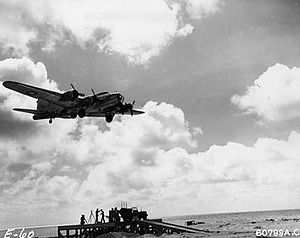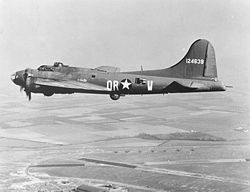Operation Aphrodite Video - Overview - Radio Controlled Airplanes
|
|
Operation Aphrodite
Aphrodite, BQ-7, BQ-8

Type: guided missile
Service history:
In service: 1944
Specifications:
Warhead: Payload: 18,000 lb (8,200 kg) Torpex
:
Guidance
system: Azon (TV sensor, radio control)
Castor (radar & TV sensors, radio control)
Castor (radar & TV sensors, radio control)
Aphrodite and Anvil were the World War II code names of United States Army Air Forces and United States Navy operations to use B-17 and PB4Y bombers as precision-guided munitions against bunkers such as those of Operation Crossbow.
The plan called for B-17 aircraft which had been taken out of operational service (various nicknames existed such as 'robot', 'baby', 'drone' or 'weary Willy') to be loaded to capacity with explosives, and flown by radio control into bomb-resistant fortifications such as German U-boat pens and V-weapon sites. It was hoped that this would match the British success with Tallboy and Grand Slam supersonic ground penetration bombs but the project was dangerous, expensive and unsuccessful.

Picture - After completing 80 323rd BS missions, Aphrodite B-17F (The Careful Virgin) was used against Mimoyecques, but impacted short of target due to controller error.
Proposal
By late 1943, Maj. Gen. Henry H. Arnold had directed Brig. Gen. Grandison Gardner's electronic engineers at Eglin Field, Florida, to outfit war-weary bombers with automatic pilots so that they could be remotely controlled. The plan was first proposed to Major General James H. Doolittle some time in 1944. Doolittle approved the plan on June 26, and assigned the 3rd Bombardment Division with preparing and flying the drone aircraft, which was to be designated BQ-7. Final assignment of responsibility was given to the 562nd Bomb Squadron at RAF Honington in Suffolk. Similarly, on July 6, 1944 the US Navy Special Attack Unit (SAU-1) was formed under ComAirLant, with Commander James A. Smith, Officer in Charge, for transfer without delay to Commander Fleet Air Wing 7 in Europe to attack German V-1 and V-2 sites with PB4Y-1's converted to assault drones.
Mission theory
Old B-17 Flying Fortress bombers were stripped of all normal combat armament and all other non-essential gear (armor, guns, bomb racks, transceiver, seats, etc.), relieving about 12,000 lb (5,400 kg) of weight. To allow easier exit when the pilot and co-pilot were to parachute out, the canopy was removed. Azon radio remote-control equipment was added, with two television cameras fitted in the cockpit to allow a view of both the ground and the main instrumentation panel to be transmitted back to an accompanying CQ-17 'mothership'. The drone was loaded with more than twice a B-17's normal bomb payload. British Torpex, 50% more powerful than TNT, was the explosive used.
A relatively remote location in Norfolk, RAF Fersfield was the launch site. Initially RAF Woodbridge had been selected for its long runway, but the possibility of the damaged aircraft that diverted to Woodbridge for landings colliding with a loaded drone caused concerns. The remote control system was insufficient for safe takeoff and each drone was taken aloft by a volunteer pilot and a volunteer flight engineer to an altitude of 2,000 ft (600 m) for transfer of control to the CQ-17 operators. After successful turnover of control of the drone, the two-man crew would arm the payload and parachute out of the cockpit. The 'mothership' would then direct the missile to the target.
When the training program was complete, the 562nd Squadron had ten drones and four 'motherships'.
Results
The only drone that hit the target did not explode, supplying the Germans with an intact B-17 and a set of radio controls. Only one drone had done any damage. The failure of the program was attributed to the lack of suitable implementations of available technology.
Mistel
References and notes
Further reading
Gray, Edwin (1996). Operation Aphrodite's B-17 "Smart Bomb". Aviation History.
Operation Aphrodite Pictures
Living Warbirds: The best warbirds DVD series.
Source: WikiPedia